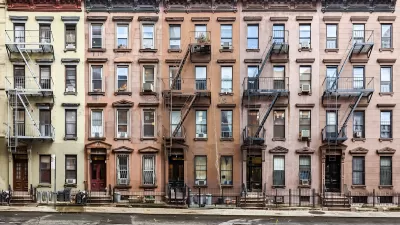A report by New York University’s Furman Center found that renters made up the majority of households in nine of the 11 largest cities in the U.S. in 2013, up from five in 2006. The demand is straining the supply of rental housing.
The report, produced with Capital One's "Investing for Good" subsidiary, "found a significant shift in the proportion of renters in all major cities—even in lower-density, relatively inexpensive places such as Houston and Dallas," write Wall Street Journal reporters Laura Kusisto and Kris Hudson.

One surprising outlier was the nation's largest city, which "no longer has the largest share of renters of any of the big cities, having been outstripped by Miami, where 65% of the population rents, a percentage point higher than New York [see Wall Street Journal graphic]," write Kusisto and Hudson. New York "is also one of several where the percentage of renters has been on a long-term decline, falling from 71% in 1970 to 64% in 2013."
Causes for the major uptick in renting nationwide varies. In some, "long-term demographic trends and changing attitudes have diminished the appeal of the traditional American dream of homeownership," they write. "But for many, slow income growth and a lack of savings are the main reasons for renting instead of buying, even as mortgage rates remain historically low."
The implications on affordable housing was one of the main findings of the report. "As the number of renters grow, if the supply of rental housing does not keep up—as it has not in most of these cities—then vacancy rates will fall, rents will rise, and more renters will struggle with the costs of housing," said Ingrid Gould Ellen, the Furman Center’s faculty director.
The report found that rents rose faster than household incomes in five of the cities and "outpaced inflation in all of the 11 cities except for Dallas and Houston, where they remained largely flat," write Kusisto and Hudson. "Rents rose the most in Washington, D.C., over the seven-year period."
View the findings of the report or the press release.
A full report with the city-specific data will be available in mid-February. To receive a copy by email, please join the NYU Furman Center mailing list.
FULL STORY: Renters Are Majority in Big U.S. Cities Even Relatively Inexpensive Places Move Away From Homeownership

Study: Maui’s Plan to Convert Vacation Rentals to Long-Term Housing Could Cause Nearly $1 Billion Economic Loss
The plan would reduce visitor accommodation by 25,% resulting in 1,900 jobs lost.

North Texas Transit Leaders Tout Benefits of TOD for Growing Region
At a summit focused on transit-oriented development, policymakers discussed how North Texas’ expanded light rail system can serve as a tool for economic growth.

Why Should We Subsidize Public Transportation?
Many public transit agencies face financial stress due to rising costs, declining fare revenue, and declining subsidies. Transit advocates must provide a strong business case for increasing public transit funding.

How to Make US Trains Faster
Changes to boarding platforms and a switch to electric trains could improve U.S. passenger rail service without the added cost of high-speed rail.

Columbia’s Revitalized ‘Loop’ Is a Hub for Local Entrepreneurs
A focus on small businesses is helping a commercial corridor in Columbia, Missouri thrive.

Invasive Insect Threatens Minnesota’s Ash Forests
The Emerald Ash Borer is a rapidly spreading invasive pest threatening Minnesota’s ash trees, and homeowners are encouraged to plant diverse replacement species, avoid moving ash firewood, and monitor for signs of infestation.
Urban Design for Planners 1: Software Tools
This six-course series explores essential urban design concepts using open source software and equips planners with the tools they need to participate fully in the urban design process.
Planning for Universal Design
Learn the tools for implementing Universal Design in planning regulations.
City of Santa Clarita
Ascent Environmental
Institute for Housing and Urban Development Studies (IHS)
City of Grandview
Harvard GSD Executive Education
Toledo-Lucas County Plan Commissions
Salt Lake City
NYU Wagner Graduate School of Public Service





























